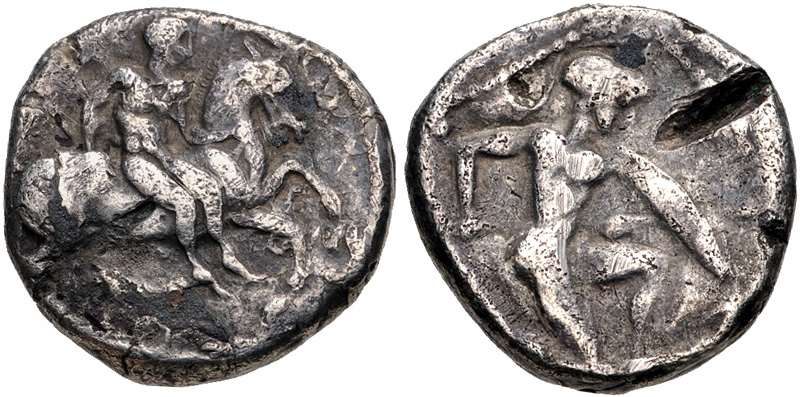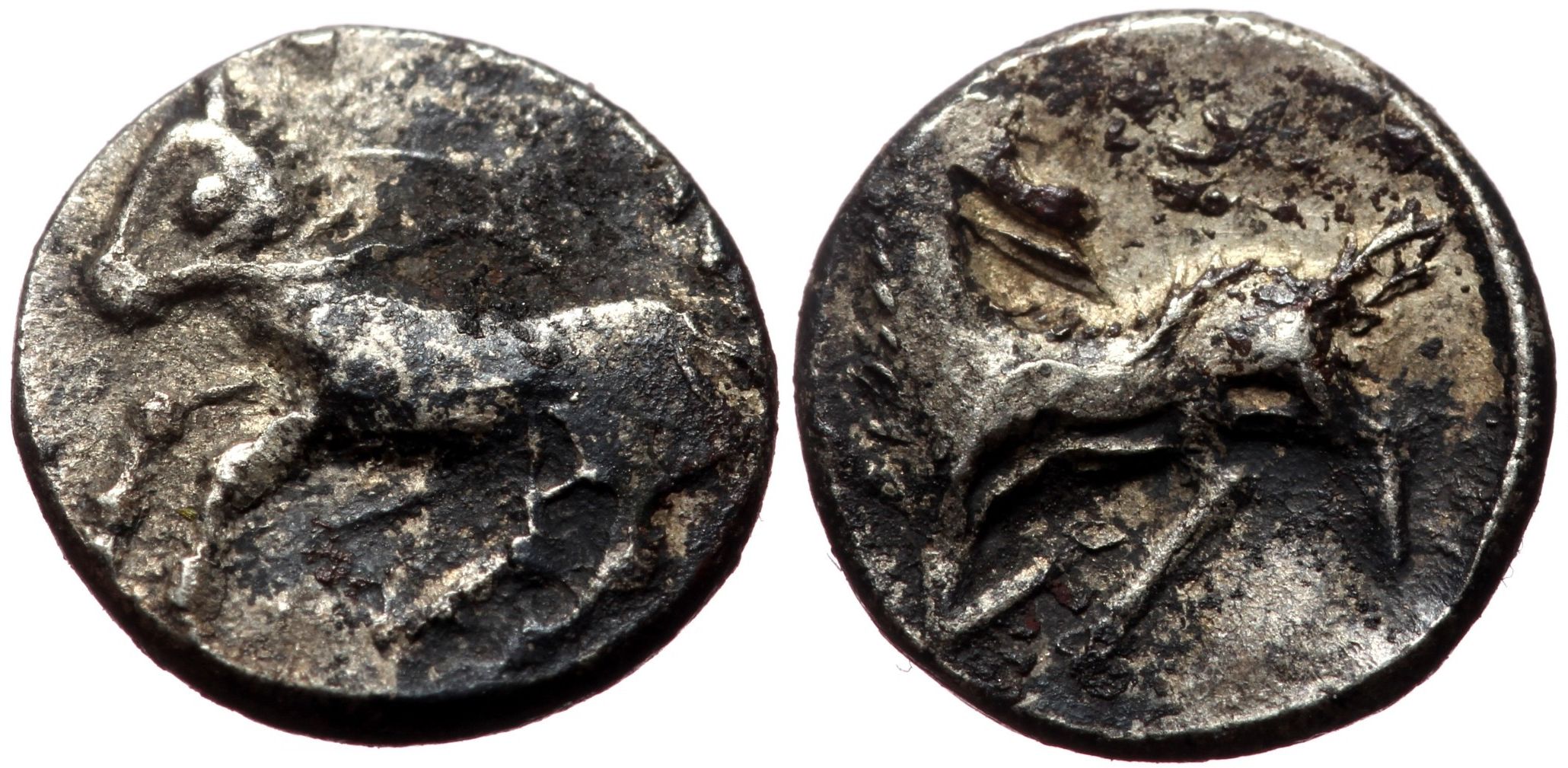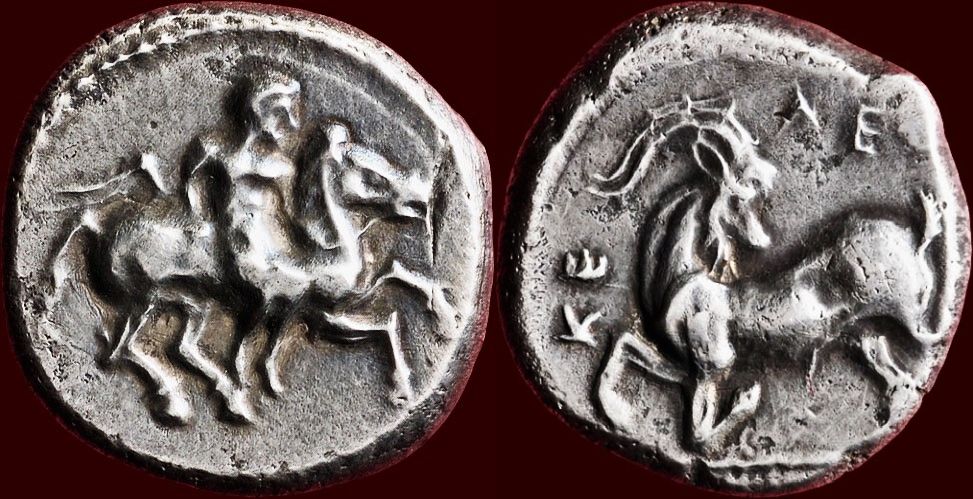| Type X.1 | |
| Denomination: | AR Stater |
Detail
| Weight: | 10.42 g (the cited specimen) | |
| Diameter: | 20 mm (the cited specimen) | |
| Obverse: | Youthful nude rider, holding reins in left hand and whip in right (?), dismounting from horse rearing to right. | |
| Reverse: | Naked hoplite kneeling right, wearing Corinthian helmet, holding spear (?) in right hand, shield in left. | |
| References: | Classical Numismatic Group, Electronic Auction 293 (19 December 2012), Lot 115 (acsearch.info URL) | |
| Credit: | Classical Numismatic Group (see the reference above) | |
| Remarks: | (1) | The coin is corroded and it may be overstruck, so many details cannot be discerned. The obverse corresponds to the Group 3. However, it is not clear whether the rider is holding a whip in his right hand or if he is merely resting his right hand on the horse’s rump. Similarly, it is not clear whether there is an exergual line under the horse and whether the scene is framed by a dotted border. The reverse corresponds to the Tarsos staters with the Great King on horseback on the obverse (for this coin type, see for example SNG France 2, 211, 212, 215, 216 and 217; for the iconographic analysis of the horseman on Tarsos coins, see Tahberer 2021, pp. 7–10). Due to the condition of the coin, however, the inscription and a potential secondary symbol are not visible, nor is the spear. |
| (2) | The interpretation of this hybrid combining an obverse of a Kelenderis stater and a reverse of a Tarsos stater is uncertain. There are probably four possibilities:
|
|
| Type X.2 | |
| Denomination: | AR Obol (?) |
Detail
| Weight: | 0.49 g (the cited specimen) | |
| Diameter: | 9 mm (the cited specimen) | |
| Obverse: | Bridled horse with loose reins rearing to left; dotted border (?). | |
| Reverse: | Goat kneeling to left, head turned back to right; above goat, unclear letters (perhaps KE reversed and retrograde). | |
| References: | SNG Levante, 30; Numismad.com Marcin Surgiewicz-Śliwiński, Auction 9 (8–9 September 2023), Lot 403 (biddr.com URL) | |
| Credit: | Numismad.com Marcin Surgiewicz-Śliwiński (see the reference above) | |
| Remarks: | (1) | This coin is of type SNG Levante, 30 (see Type 5.11a) and may have been struck with the same reverse die, but based on the small photograph in SNG Levante it is impossible to say for sure. Both of these coins are characterized by a low weight for the type: 0.55 g Levante 30 and 0.49 g this coin, while the average weight of Type 5.11 is 0.72 g with a standard deviation of 0.06 g, see Weight analysis of Kelenderis obols. The crude style of this coin and the anatomically strange placement of the back legs of the goat are atypical for Kelenderis. It is therefore highly probable that it is a contemporary imitation. However, the Levante 30 coin is included in the main catalogue under Type 5.11a, as its small photograph does not allow to decide for sure whether it is an analogous imitation. |
| (2) | The only other specimen of the Levante 30 type that I know of is mentioned in the Classical Numismatic Group catalogue, Auction XXVI (11 June 1993), Lot 293. It is labeled here as a hemiobol, but its weight is not given and its photograph is not included. | |
| Type X.3 | |
| Denomination: | AR Stater |
Detail
| Weight: | 10.28 g (the cited specimen) |
| Diameter: | 21 mm (the cited specimen) |
| Obverse: | Youthful nude rider, holding reins in left hand and whip in right, dismounting from horse rearing to right; dotted border. |
| Reverse: | Male goat kneeling to left on exergual line, head turned back to right; before and above goat, KE–ΛE. |
| References: | Munthandel G. Henzen, Fixed Price List, ID 72135 (accessed 22 October 2023) |
| Credit: | Munthandel G. Henzen (see the reference above) |
| Remark: | This coin corresponds to Type 3.1, but is probably an ancient imitation for two reasons. First, the blurred details cannot be explained by a weak strike, so the official dies would have to be worn out. However, this would mean that a large number of coins were struck from these dies, but this variant of Type 3.1 is otherwise unknown. Second, although the obverse image is very blurred, its clumsy style is evident. In particular, the proportions of the horse’s neck relative to its head are unusual, the relative position of the horse’s hind legs is unrealistic, and the whip handle is too robust relative to the rider’s hand and at the same time its lower part ends high above the horse’s back (the worn die could have been coarsely retouched, but then the whip handle would extend to the rider’s palm). |
25 April 2023 – 22 October 2023


